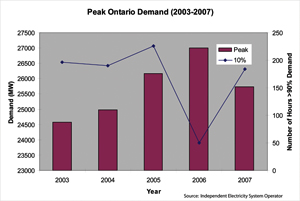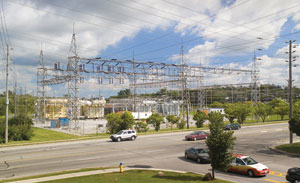
Caroline Lofthouse
Ontario’s electricity industry faces a number of challenges over the coming years. The growing concern about greenhouse gas emissions from coal-powered generation, and aging infrastructure that requires the replacement of 80% of its generation assets must be balanced against increasing electricity demand. The Ontario Power Authority (OPA), whose mandate is to ensure the long-term reliability of Ontario’s electricity supply, released its Integrated Power System Plan (IPSP) this past summer. This plan proposes phasing out coal power (representing 18% of the current installed resources) and the near doubling of electricity generated from renewable sources.
Although once neglected, the consumer as a resource has become a critical component of managing Ontario’s power supply. The OPA has set the ambitious goal of integrating 6300MW of Conservation and Demand Management (CDM) into the province’s supply mix by 2025. The deregulation of Ontario’s electricity market, the blackout of 2003, power warnings and air advisories have generated public awareness that electricity is a resource not to be taken for granted. This growing public consciousness of the environmental and economic consequences of electricity use has primed the market for CDM programs. This was demonstrated last August 2nd. The second day into a power advisory, the Independent Electricity System Operator (IESO) projected Ontario’s demand to peak at 26,502MW. However, as a result of engaging the public through appeals to reduce electricity use and the implementation of various Demand Response (DR) programs, Ontario’s demand reached a peak of just 25,584MW that day.
As the CDM market is established in Ontario, DR is quickly emerging as a flexible, real-time solution to securing Ontario’s power supply during times of peak demand. Where conservation seeks to lower overall consumption, demand management through DR programs, reduces peak demand. By promoting a more efficient use of electricity resources, DR programs can help mitigate power supply issues and lower the price of electricity and in doing so, promote economic benefits.
DR can play a critical role in system planning. Ontario’s peak demand of 27,005MW was recorded on August 1st, 2006, however demand exceeded 24,000MW for just 58 hours or 0.7% of that year. In comparison, the extreme hot weather conditions during summer 2005, saw the total demand for that year exceed 24,000MW for 154 hours or 1.8%. Through engaging consumers to reduce electricity usage during, for example, the top 100 hours, system planners can potentially reduce the peak demand by 5-10%. The OPA is set to do just that. Launching a suite of DR programs, the OPA has established a province-wide market to further integrate this resource into Ontario’s power supply mix.

DR BENEFITS
By actively engaging demand-side modification, both market operators and participants provide numerous benefits to the province:
Capital Security
Reducing peak demand minimizes the requirements for more generation, transmission and distribution assets. The IPSP proposes a supply mix totaling approximately 35,000MW to meet Ontario’s demand of 2025. Without the 6300MW of proposed CDM, an additional 4000MW of generation would need to be installed, requiring additional transmission and distribution
assets to accommodate the increased grid capacity. Since peak demand often represents no more than 200 hours a year, this new infrastructure may very likely sit idle 95% of the time. By actively engaging consumers to conserve during times of peak demand, market planners and operators reduce the need for costly new infrastructure.
Supply Certainty
Declining capacity margins and the proposed transition to a ‘greener’ supply mix for Ontario present challenges to meeting the province’s growing electricity demand. In fact in the most recent 18-Month Outlook published, the IESO clearly demonstrates the growing importance of CDM in keeping Ontario’s lights on:
* “Under the normal weather scenario, sufficient resources will be available within Ontario to meet expected requirements during all but one week over the next year and a half. For this to occur, all of the planned resource additions must meet their stated in service targets and the aggressive conservation targets set by the Ontario Power Authority (OPA) must be achieved.”
DR is an integral component in CDM planning as it allows market operators to respond to system constraints in real-time. Where capacity margins fail to provide an adequate supply ‘buffer’, DR resources can quickly be dispatched to reduce demand to meet the available supply.
Furthermore, DR provides a needed flexibility as coal-power resources are replaced with renewable energy sources. As the province transitions to a greener supply mix and looks to replace aging infrastructure, DR is the most effective way to reduce electricity consumption on a short-term basis and support the province’s green initiative.
Market Efficiency
Increased demand equals increased price in virtually any market. Price volatility in response to increased demand is commonplace in Ontario’s electricity market. For example, record setting peak of 27,005MW on August 1st, 2006 saw prices rise from $112.17 in Hour 9 (24,443MW) to reach a maximum of $226.73 in Hour 12 (26, 712MW). This represents a doubling of price from an increased demand of just 2274MW. A similar scenario was observed the following day (Aug 2nd) when prices rose from $104.62 in Hour 9 (23,524MW) to reach a daily maximum of $317.76 in Hour 14 (25,816MW). In fact, on Aug 2nd the price doubled from $149.59 (Hour 13; 25,643MW) to $317.76 (Hour 14; 25,846MW) from an increased demand of only 173MW.
Price variability can be caused by either increased demand or supply-side constraints. In either case, a reduction in demand can help lower the wholesale market price. According to the Federal Energy Regulation Commission’s 2007 report entitled Assessment of Demand Response & Metering, in the summer of 2006, DR activities actively reduced market prices. The Midwest Independent System Operator reported a reduction $100-200/Mwh in the market clearing prices with a DR curtailment of $2,650MW on August 1st. The following day, PJM reported that DR lowered energy prices by more than $300/MWH on the operator’s record peak day.
Carbon Currency
As increasing pressure is put on governments to address the issue of human-induced global warming, much attention in Ontario is focused on closing the coal power plants. Ontario Power Generation, the organization charged with operating over 22,000MW of installed generation capacity in the province, reported 25,932,840 tonnes of carbon dioxide emissions resulting from the operation of Ontario’s five coal-power generation stations in 2006.
The IPSP proposes the closing of all of Ontario’s coal power plants by 2014. Consumer behaviour will be key to achieving this goal. DR provides energy consumers a platform on which to minimize their own carbon footprint and help phase-out coal from Ontario’s supply mix. In addition, DR provides large energy consumers an opportunity to participate in emerging carbon-trading markets.
The DR market in Ontario is in its infancy. Existing programs target specific geographic areas or certain markets. The population growth in York Region, just north of Toronto, has outpaced its supply infrastructure resulting in the implementation of a number of DR programs. The IESO has the Emergency Load Reduction Program as a resource of 100MW+ to be dispatched during times of supply-side constraints.

This year the DR market is expected to become even more established through out the province with the release of a suite of DR programs from the OPA aimed at increasing grid system reliability and moderating market price. Through the role of load aggregators, the market will be open to all consumers of 50kW or greater. The OPA’s DR3 Program provides the financial incentives necessary to develop and effective DR market in Ontario and makes load aggregation economically feasible.
This emerging market would be limited to only the largest energy consumers were it not for the province’s Smart Meter and Meter Data Management and Repository (MDM/R) initiatives targeting residential and small commercial consumers. Enabling technologies and infrastructure are fundamental to the integration of DR resources in Ontario’s power supply.
ADVANCED METERING INFRASTRUCTURE
Effective measurement & verification of curtailment activity is largely dependent on Advanced Metering Infrastructure (AMI). Smart or interval meters record customers’ consumption on an hourly basis, store and transmit this information over fixed networks for use by customers, utilities or grid operators. This allows timely retrieval of consumption for the purpose of verifying a directed DR event.
Until recently, generally only those customers using greater than 250,000 kWh/year had interval metering installed at their facility. In 2005, the Ontario government committed to the installation of smart meters for all customers by 2010. When this technology is in place, the customer, regardless of size, is provided the tools to modify consumption and respond to real-time pricing. Through the implementation of smart meters across the province, the consumer will quickly learn that when electricity is being used is as important as how much is used. DR initiatives can then easily be provided to residential & small business consumers.


Data collected through all Ontario smart meters will be forwarded to the province’s MDM/R, which is then verified and downloaded to the utilities for billing purposes. The single location for data collection is advantageous in that it ensures the standardization of data, greatly increases accessibility and provides universal applicability of the information collected.

The implementation of AMI & MDM/R will open up the possibility of DR participation in Ontario over the coming years. Open access for third parties to the communications infrastructure and the meter data will greatly increase the ease with which electricity consumption is measured and demand reductions are verified. However, challenges remain both in planned infrastructure and DR market evolution. To fully realize the DR potential of Ontario consumers, technologies and DR program design needs to expand to ensure the Ontario’s CDM targets are met.
Load Potential
The current implementation of AMI in Ontario is focused largely on residential loads. Without sufficient technology in place, it often is not economically feasible for small businesses to participate in DR programs as the cost of installing necessary metering would exceed the financial benefits offered.
Pulse Outputs
Smart meters installed provide hourly data, yet DR measurement and verification requirements put forth by the OPA for DR3 require 5-minute interval data. Such a requirement, without sufficient technology already in place, can make the aggregation of smaller loads cost prohibitive, thus excluding a large proportion of electricity consumers from participation. Also, daily uploads of data to the MDM/R limits real-time access for the end user requiring additional hardware for DR participation.
Communication
Two-way communication networks greatly increase DR capacity by enabling the grid operator or aggregator to control a participant’s consumption and provide necessary price information to the consumer and in-home devices. For effective and reliable demand curtailment, it is highly beneficial for the program manager, aggregator and end user to be able to receive data and modify consumption remotely. Ontario’s AMI currently limits communication and real-time access to usage data.
Stakeholder Cooperation
The success of Ontario’s emerging DR market isn’t limited to effective technological communication but also communication between the stakeholders. Distribution utilities play a key role as they are often first line of contact for the consumer. DR can greatly enhance a utility’s CDM portfolio. By providing an additional service, it presents a customer relations opportunity from which both parties may benefit. Distribution utilities have an established relationship with the customer, own the metering infrastructure and the customer’s load profile and thus have a vested interest in the DR participation of their customer.
Ontario Government agencies such as the OPA and the IESO enable the development of the DR market. Through program design and implementation, these regulators set the parameters and provide the incentives for end-user and third party participation. The customer and the aggregator are the critical pieces of the DR puzzle. For a DR market to successfully develop, no party can act as a silo. Cooperation and communication between these parties are essential. Each market player has a valuable role in its success.
Looking Beyond
AMI provides the framework for the evolution of a dynamic electricity grid by giving all consumers the necessary information to change their behaviour in response to pricing or reliability concerns. AMI is the key to integrating DR, Distributed Energy Systems, Consumer Energy Management Systems, Distributed Automation and Smart Appliances into Ontario’s Smart Grid of the future. Design flexibility and ready access to information for future demand-side measures need to be considered now during the implementation of smart meters in the province.
In addition to technological advances in the market, DR can also be highly beneficial in market design. Competing with generation resources in the supply mix, DR provides an economic alternative to acquiring additional generation to meet demand. As seen in day-ahead markets in New York State, buying back load is just as effective as generating electricity when the market price is sufficient. Balancing supply and demand is no longer a one-way transaction.
The integration of DR resources into Ontario’s power supply is a challenging but necessary step in meeting the province’s growing electricity demand. The IESO projects demand growth of 1% per year on average. As the supply mix transitions to that proposed by the IPSP, consumers will have an increasing role in securing the power supply of the province. DR provides the incentives to the end user and needed flexibility in system planning to respond to real-time supply constraints.
The enabling technologies associated with AMI and MDM/R are just the first step in developing Ontario’s DR market. As a relatively new concept to the province’s consumers, an effective educational campaign is required to introduce DR and the benefits to all consumers. By providing the tools to the consumer, whether in the form of technology or information, system planners empower the consumer with the ability to make a difference.
* 18-MONTH OUTLOOK: An Assessment of the Reliability of the Ontario Electricity System From January 2008 to June 2009. Independent Electricity System Operator, Dec 17th, 2007
ABOUT THE AUTHOR
Caroline Lofthouse is the Communications Specialist for Rodan Energy & Metering Solutions located in Missisauga, Ontario. As a Metering Services Provider licensed with the IESO, Rodan provides high voltage metering and power systems engineering services as well as a full suite of sub-metering, data management and settlement solutions. Under its EnerShift brand, Rodan has become the leading provider of demand response and energy efficiency aggregation services in Ontario. Caroline joined Rodan in 2006 upon completion of a M.Sc. from York University in Toronto, ON.







